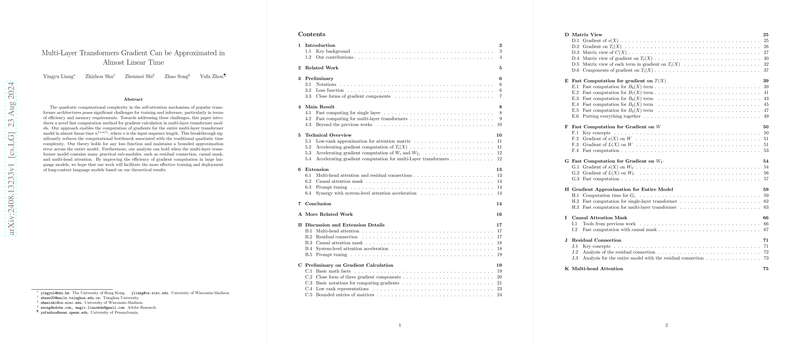Analyzing Efficient Gradient Computation in Multi-Layer Transformers
The paper titled "Multi-Layer Transformers Gradient Can be Approximated in Almost Linear Time" by Yingyu Liang et al. addresses a pivotal challenge in the training and inference of transformer models, particularly their computational inefficiency due to quadratic complexity in the self-attention mechanism. This paper introduces methods to approximate the gradients in multi-layer transformers in almost linear time relative to the length of the input sequence. These findings hold significance as they promise reductions in computation and memory burdens, fostering more feasible training and deployment of expansive LLMs that manage long-context information.
Background and Challenges
Transformers, and specifically their self-attention components, are foundational to LLMs. However, the quadratic computational complexity associated with calculating attention scores presents significant efficiency challenges, particularly as the context length increases. For example, training high-end models like LLAMA 3.1, with 405B parameters, underscores the necessity for more efficient computations, given their considerable resource requirements evident from the 30.84M GPU training hours this model demands. Key challenges include:
- Decreased Training Efficiency: Extensive context lengths slow training processes.
- Memory Constraints: Handling large quadratic matrices necessitates substantial memory.
- Energy Consumption: Increased computational demands lead to greater energy usage, and consequently, higher carbon emissions.
Contributions and Theoretical Insights
The primary contribution of this paper is its algorithm capable of approximating gradients of a multi-layer transformer in almost linear time —this substantially mitigates the traditionally prohibitive time complexity. This algorithm generalizes to any loss function, demonstrates bounded approximation errors across the model, and integrates pertinent practical sub-modules such as residual connections and causal masks.
Key contributions are encapsulated as follows:
- Algorithm (ALTGrad)
- Capable of computing gradients for self-attention layers with complexity .
- Extends the approximation to a multi-layer transformer, maintaining the error within $1/poly(n)$.
- The approach ensures the feasibility of training LLMs efficiently while accommodating practical modules such as multi-head attention and residual connections.
Implications and Future Directions
Implementing the innovative gradient approximation technique, which leverages polynomial kernel approximations, not only optimizes the computation within transformers but also extends their practical usability with substantial energy and memory savings:
- Training Efficiency: By transforming the quadratic time complexity to an almost linear framework, the training processes for LLMs become more viable at scale.
- Resource Management: The reduced memory requirements and computational costs bolster the feasibility of deploying long-context LLMs in resource-constrained environments.
- Energy Efficiency: The optimization contributes to greener AI practices by reducing the energy footprint of computationally intensive tasks.
Extensions and Synergies
Further explorations include extending the precepts of this paper to enhanced multi-modal models, math reasoning tasks, and privacy-preserving models. The algorithm's adaptability to multi-head attention, causal masks, and residual connections signifies its robustness in diverse machine learning contexts.
Additionally, integrating this almost linear time complexity improvement with system-level attention acceleration techniques (e.g., Flash Attention) can amplify the overall efficiency. Future work on embedding this theoretical advancement within practical GPU implementations—from devising new tensor operations in PyTorch to optimizing CUDA functions—holds promise for actualizing the full potential of the proposed methods.
Conclusion
The proposed methodology enables approximating gradients in transformer-based models in a near-linear time frame, significantly easing the computational bottleneck apparent in conventional models. This theoretical breakthrough aligns with the ongoing quest to make large-scale LLMs not just powerful but also computationally feasible and environmentally sustainable.
By addressing the critical aspects of computational efficiency and resource optimization, the paper by Liang et al. lays the groundwork for more scalable and ecologically responsible AI practices, pushing the boundaries of what transformer models can achieve in both research and industry applications.
